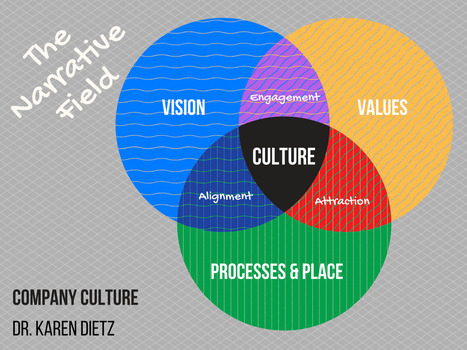 Your new post is loading...
 Your new post is loading...
Here’s the dilemma: In a competitive, complex, and volatile business environment, companies need more from their employees than ever. But the same forces rocking businesses are also overwhelming employees, driving up their fear, and compromising their capacity. It’s no wonder that so many C-Suite leaders are focused on how to build higher performance cultures. The irony, we’ve found, is that building a culture focused on performance may not be the best, healthiest, or most sustainable way to fuel results. Instead, it may be more effective to focus on creating a culture of growth. A culture is simply the collection of beliefs on which people build their behavior. Learning organizations – Peter Senge’s term — classically focus on intellectually oriented issues such as knowledge and expertise. That’s plainly critical, but a true growth culture also focuses on deeper issues connected to how people feel, and how they behave as a result. In a growth culture, people build their capacity to see through blind spots; acknowledge insecurities and shortcomings rather than unconsciously acting them out; and spend less energy defending their personal value so they have more energy available to create external value. How people feel – and make other people feel — becomes as important as how much they know. Building a growth culture, we’ve found, requires a blend of individual and organizational components: An environment that feels safe, fueled first by top by leaders willing to role model vulnerability and take personal responsibility for their shortcomings and missteps.A focus on continuous learning through inquiry, curiosity and transparency, in place of judgment, certainty and self-protection.Time-limited, manageable experiments with new behaviors in order to test our unconscious assumption that changing the status quo is dangerous and likely to have negative consequences.Continuous feedback – up, down and across the organization – grounded in a shared commitment to helping each other grow and get better.
Via The Learning Factor
Companies want to be profitable and maximize their performance and impact both in the world and within their industry. With that said, accomplishing those feats starts with cultivating a culture to allow those things to happen which starts with a priority on employee well-being. Culture is important -- it affects engagement, mindset, reputation, recruitment of talent, and well being. When looking to cultivate a healthy and high performing culture, start by emphasizing these six points:
Via The Learning Factor
Focusing on a “critical few” behaviors is one of the fundamental tenets of working effectively with organizational culture. Sometimes called keystone behaviors, these are patterns of acting that are tangible, repeatable, observable, and measurable, and will contribute to achieving an organization’s strategic and operational objectives. The behaviors are critical because they will have a significant impact on business performance when exhibited by large numbers of people; they are few because people can really only remember and change three to five key behaviors at one time.
In the work done by Katzenbach Center consultants around the world, we have seen how a focus on a critical few behaviors helps bring about changes that contribute to meaningful business outcomes, whether it is a medical devices manufacturer tallying 10 straight quarters of revenue growth or a technology firm saving US$100 million a year in warranty costs.
Via David Hain
A company’s culture can be found it its values, behaviors, and visible artifacts like employee dress, interior design, and signage. What impact can you make?
Perks aren't all fun and games; they form an important pillar of your culture.
We live in an age of increased complexity, velocity and demand for multidisciplinary thinking. So much of what we do today requires the careful balance of both generalists and specialists to make great work happen. It excites me to see more and more organizations embrace this approach by bringing together people from multitudes of fields and perspectives, enabling a new depth and diversity of visioning and problem solving. Optimally, these multidisciplinary teams are further supported through evolved organizational and management-thinking that favors meritocracy over rigidity. Organizationally, this can be achieved by constructing horizontal networks where there were once more stacked seniority-based hierarchies. In practice, managing people and teams of this sort requires every bit as much care and rigor as more traditional structures, but the energies are directed differently — there's more attention directed toward supporting relevant possibilities and valuable outcomes than reinforcing structure. The investment is worthwhile, because when it works, the results and cultural implications are magnificent.
Via The Learning Factor
The first thing most of us do when working with people from a new culture is to learn about differences. And there are very sensible reasons to do so. It helps you avoid cultural faux pas. For example, if your Korean employee will likely be embarrassed if you praise him in public, it would be good to know that ahead of time so you can anticipate his reaction and alter your own behavior plan. Similarly, if you know that an American employer expects you to look her in the eye, give a firm handshake, and speak positively about yourself, it’s important for you to know that as well, even if those very same behaviors would be considered inappropriate where you come from. Focusing on cultural differences also helps you learn to correctly interpret and make sense of the behavior of others.
Via The Learning Factor
It takes courage to listen. Whether it’s a first or fifth transition to a new leader role, these non-profit leadership lessons learned are timeless. Pause, reflect. choose, (from horse-guided leadership & learning.) In the first months, resist the urgent and not important to follow these practical steps to ensure your success. ______________________
It takes courage to listen & learn, as a new leader.
_______________________ What I learned at the University of Michigan early on was the power of the conversation. Listening builds relationship. Listening well has impact as a leader with groups of new direct reports, with peers and colleagues, ALL of them await a new leader’s first steps and actions. Each. Encounter. Equals. Opportunity. To. Connect.
John Taylor, CEO of the Association of College Unions International (ACUI) had this to say about the series:
“As a new CEO, the article’s main points to invest time in learning, building relationships, and establishing priorities have been key during my first six months on the job.”
I interviewed John before he left his role at the University of Michigan. His view is a fresh insight to help this year's new leaders. Note that although we make reference to associations throughout the posts, these tips apply to any non-profit organization and are adaptable to the for-profit sector as well.
EXCERPTS from the full article derived from -- "Seven Ways New Non-Profit Leaders Succeed the First Year on the Job" 1. LISTEN to Learn In many high-pressure environments, deep listening distinguishes the highly experienced from the amateurs. ...One association executive advised his peers to “resist the temptation to prove how bright you are; do nothing when you first arrive—just learn.”
...Develop a list for listening interviews including staff, board members, active volunteers, randomly selected members, dropped members, industry leaders, subject matter experts, external partners, and others. Everyone has something to say; they ...will be encouraged by your desire to learn. Ask open-ended questions. Prepare to be surprised. Though many relationships will deepen during your tenure, early conversations can provide unique opportunities for candid exchanges unencumbered by baggage, fears, or agendas.
2. COMMUNICATE! ...Information for your staff is usually under-communicated by a factor of four.
Here are a few things to keep in mind: Staff members are vitally interested in what the boss [senior leadership team, executive committee, board] just talked about. Find a way to share it regularly. The board should be vitally interested in progress toward strategic goals. Find a way to check on this. Committees and other volunteer groups don’t know what other committees and groups are doing. Summarize, align, and share. Members and constituents want to know “What’s in it for me?” They will appreciate understanding the logic behind board decisions. Find a way to test, confirm and communicate this regularly.
Via Deb Nystrom, REVELN
All workplaces have some challenges and negative characteristics, so it can be difficult to determine if your workplace has a normal amount of challenges, is seriously dysfunctional, or possibly really toxic. Here are five signs that will help you determine the degree to which your work environment may be dangerous to your mental health. 1. Unhealthy Communication Patterns An initial sign of a dysfunctional, toxic workplace is that there are significant problems in communication, and often across multiple areas—between employees and their supervisors, from management to supervisors, across departments, with suppliers, and even with customers.
Via The Learning Factor
If you said “no” to any of the above, you’re probably not indispensable to your employer. But you should strive to be, says Chris Gaborit, managing director and cofounder of The Learning Factor, in a recent LinkedIn post. In the post, Gaborit offers keys to becoming indispensable at work. “I decided to get some wisdom from people I respect,” he says. “I asked some of our best clients — senior managers who work for global companies. These people have walked the walk; they have been bulletproof when it comes to restructuring.” Here are two ways to become indispensable at work:
Via The Learning Factor
Givers are the kinds of people who will go out of their way to help others with no strings attached. This is in comparison to matchers--those who believe in an eye for an eye--and takers--people who are always trying to get as much as they can out of others. Grant, a professor of management at the Wharton School of the University of Pennsylvania, spoke about his research on these three character profiles Wednesday at the annual Inc. 5000 conference in Phoenix. Grant found that overly generous people tend to fail in the short term, but succeed in the long run. Their failures are due to the fact that they often get trampled by the takers around them. However, if you as a leader, can weed out the greedy ones, you can pave the way for your employees', and your organization's, long-term success.
Via The Learning Factor
|
Every year for the past ten years, Glassdoor announces the top places to work all across North America and parts of Europe. The most unique part of this award? You can only win the award if your employees say so. Glassdoor's methodology for the award includes a collection of anonymous company reviews where employees share their honest opinion on pros and cons of working for the company, overall satisfaction, the CEO, and workplace attributes. They're also asked if they would recommend their employer to a friend. It's a juicy turn of the tables. Within the top 100 best places to work for, the industries that came out on top were tech, retail, healthcare, consulting, finance, and travel and tourism. The top cities included the Bay Area, Boston, and Los Angeles (just to name a few). So, what does it take to be the top of the top?
Via The Learning Factor
Whenever any new technology emerges that challenges the way people and businesses have been doing things for years or even decades, the initial excitement is often overshadowed by uncertainty and reluctance to try something new. In the early days of the cloud, it was almost inconceivable to think that it would lead to such a profound shift in how businesses operate. More recently, the drive toward digital transformation has caused even greater anxiety in some organizations. In this age of digital transformation, all industries -- from manufacturing and banking to hospitality and retail -- are evolving. This means that decision makers must identify key business issues, not technology issues, that digital transformation can tackle. Companies need to not only harness the power of the latest digital technologies and platforms to stay relevant and competitive but also course-correct their business models based on evolving customer demands. This type of transformation should be seen as a journey, not a destination. It is a cycle of change and progress, both from a technological and organizational standpoint. It’s about constantly reassessing opportunities to do things better, faster and with greater scale in the evolving environment in which one’s business operates.
Via The Learning Factor
According to a seven-year study on workers’ performance, an inability to make this break between professional and personal time ranked among the top-10 stressful situations that people were least effective at handling. Technology has, of course, exacerbated the problem, offering both convenience and imposition, by putting our workplaces just a touch screen away. How can we all do a better job of leaving work at work, so our home lives become more pleasurable and less stressful? Before leaving the office… Do one more small task. Make a short phone call, sign a document, or respond to an email. This way you end your day on a positive note of completion. There’s gratification in knowing that you elected to push yourself and now have one less thing to do the following morning. And, as research from Teresa Amabile and Steven Kramer, authors of The Progress Principle, has shown even “small wins” can enhance your mood. Write a to-do list. On paper or digitally, make a record of all the tasks you need to accomplish, ideally in order of importance. When my organization worked with the New York Presbyterian Hospital Cornell Medical Center to survey more than 1,000 workers living in the northeast we found that the practice of building such lists was among the top three most effective skills for enhancing work performance and positively redirecting stress.
Via The Learning Factor
As a leader, if you don’t like the culture that exists in your organization, you must understand your role in it, and your ability to address it.
Via donhornsby
Companies can tap their natural advantage when they focus on changing a few important behaviors, enlist informal leaders, and harness the power of employees’ emotions.
Via Strategic Leadership Group
In last week’s blog “Do you know how to overcome the key barriers to change?” I outlined two key barriers that will challenge your ability to stay the course when transforming your organization to the next level, and how to overcome them. The first one was: “Not tolerating a temporary dip in performance and/or results” …
Anyone who’s celebrated a significant work anniversary knows just how a company can change over the years—who has a seat at the table, what customers expect, the most coveted skills. But there’s just as much that stays the same: what your brand stands for, the shared lexicon, your unique culture. We use the term organizational DNA as a metaphor for the underlying organizational and cultural design factors that define an organization’s personality and determine whether it is strong or weak in executing strategy.
Via The Learning Factor
If the answer to these last two questions is “rarely,” it wouldn’t surprise us. We don’t believe that swift, wholesale culture change is possible — or even desirable. After all, a company’s culture is its basic personality, the essence of how its people interact and work. However, it is an elusively complex entity that survives and evolves mostly through gradual shifts in leadership, strategy, and other circumstances. We find the most useful definition is also the simplest: Culture is the self-sustaining pattern of behavior that determines how things are done. Made of instinctive, repetitive habits and emotional responses, culture can’t be copied or easily pinned down. Corporate cultures are constantly self-renewing and slowly evolving: What people feel, think, and believe is reflected and shaped by the way they go about their business. Formal efforts to change a culture (to replace it with something entirely new and different) seldom manage to get to the heart of what motivates people, what makes them tick. Strongly worded memos from on high are deleted within hours. You can plaster the walls with large banners proclaiming new values, but people will go about their days, right beneath those signs, continuing with the habits that are familiar and comfortable. But this inherent complexity shouldn’t deter leaders from trying to use culture as a lever. If you cannot simply replace the entire machine, work on realigning some of the more useful cogs. The name of the game is making use of what you cannot change by using some of the emotional forces within your current culture differently.
Via The Learning Factor
Global team leaders who unleash ideas, we find, are those who: 1) ask questions, and listen carefully; 2) facilitate constructive argument; 3) give actionable feedback; 4) take advice from the team and act on it; 5) share credit for team success; and 6) maintain regular contact with team members. Members of global teams whose leaders exhibit at least three of these behaviors are more likely than global team members whose leaders exhibit none of these behaviors to say they feel free to express their views and opinions (89% vs 19%) and that their ideas are heard and recognized (76% vs 20%). Research we conducted at the Center for Talent Innovation reveals a remarkable correlation between inclusive leadership, innovative output, and market growth.
Via The Learning Factor
Looking at someone’s education and background can be helpful when screening job candidates, but the best indicator of who’s the right fit can’t always be found on a résumé. Companies ranging from big names like Pinterest to small startups are conducting culture interviews to build cohesive teams that match the feel of the office—not just the job description. "Relying on someone’s background can be very misleading; it doesn’t tell the whole story," says Tara Kelly, CEO of the customer experience software provider SPLICE Software. "Our workplace is like a family, and we are always looking for someone who is the right fit." Culture interviews are part of the SPLICE hiring process, and the process starts with the job ad, which includes quotes from current employees about what it’s like to work at the company. Kelly says she hopes this added insight attracts the right applicants.
Via The Learning Factor
Have you ever been in a job you hate so much that waking up is painful? Have you ever wished that you were born a different person with a different life? Have you ever hoped that an alien spaceship would capture your manager? There have been times in my life I thought these things.Years ago there a young grandfather who lived in Versailles, Indiana. He decided to have a sleep after lunch. While he lay on the couch his young 8-year-old grandson decided to play a trick on him and rubbed some smelly
Via The Learning Factor
Who is a better leader? A clock builder or time teller? Jim Collins, the foremost management guru, poses a very interesting question in his best-selling book "Built to Last: Successful Habits of Vi...
Via Prof. Hankell, Dan Forbes
|



 Your new post is loading...
Your new post is loading...














































You need four things to do it.